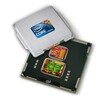Intel Core 2 Duo P7550 vs Intel Core i5-460M vs Intel Core 2 Duo P7450
Intel Core 2 Duo P7550
► remove from comparisonDer Intel Core 2 Duo P7550 Dual-Core Prozessor bietet zwei Prozessorkerne mit einem gemeinsamen Level 2 Cache von 3 MB. Der P7550 ist baugleich zum Core 2 Duo P8400 und P7570, bietet jedoch keine Virtualisierungsfunktionen (VT-x) und keine Unterstützung für Trusted Execution Technology. Die Architektur des OEM Prozessors basiert auf den Penryn Kern und wird in 45nm gefertigt.
Für Multimediaanwendungen und anspruchslose Spiele, sollte die Performance des Intel Core 2 Duo P7550 ausreichen. Im Vergleich zu AMD sollte die Performance auf Niveau der schnellsten Turion II Ultra mit 2.4 - 2.6 GHz liegen. Anspruchsvolle Spielefans sollten jedoch eher zu höher getakteten Core 2 Duo CPUs greifen (>2.5 GHz).
Der Penryn (Montevina Update) Kern bietet 2 Integer Units, 1 Floating Point Unit, 1 Load Unit und 1 Store Unit in einer 14-stufigen Pipeline. Mit der Wide Dynamic Execution Technologie kann der Kern bis zu vier volle Instruktionen gleichzeitig ausführen.
Dank Dynamic Acceleration (später Turbo Modus genannt), kann sich ein Kern um eine Stufe übertakten, wenn der zweite im Idle Modus (Leerlauf) ist.
Das integrierte Enhanced Speedstep kann die Taktfrequenz des Prozessors dynamisch an die Leistungsanforderungen anpassen. Dadurch läuft die CPU ohne Last nur mit 800 MHz.
Intel Core i5-460M
► remove from comparison
Der Intel Core i5-460M ist ein zwei-Kern Prozessor für Notebooks und taktet dank Turbo mit max. 2.53 - 2.8 GHz je nach Auslastung / TDP Ausnutzung. Die zwei Kerne basieren auf die Nehalem (Westmere) Mikro-Architektur und können dank Hyperthreading 4 Threads gleichzeitig abarbeiten. Die Leistung des 460M ist in der Mittelklasse anzusiedeln. Im Vergleich zum Core i5-540M fehlen die AES, VT-d und Trusted Execution Funktionen und der Turbo taktet etwas weniger hoch.
Eine Besonderheit der neuen Dual-Core CPUs von Intel ist die Integration des Speichercontrollers und einer integrierten Grafikkarte (GMA HD) in das Package. Die CPU wird bereits in 32nm hergestellt, der Die für den Speichercontroller und die Grafikkarte jedoch noch in 45nm.
Dank Turbo Boost Technologie kann der 460M die Rechenkerne und auch die Grafikkarte je nach Last übertakten (CPU-Kerne in 133 MHz Schritten). Dies ist jedoch von der Art der Auslastung und der Kühlung abhängig. Grafikkarte und CPU-Kerne können wahrscheinlich nicht gleichzeitig übertaktet werden. Da jedoch praktische Anwendungen und Spiele meist nicht die Kerne voll auslasten, zeigt sich der Turbo in der Praxis als äußerst wirksam. Jedoch läuft die CPU unter Last viel häufiger an der TDP Grenze, also z.B. der Core 2 Duo Vorgänger.
Dank des integrierten Speicherkontrollers, Hyper-Threading und Turbo Boost, kann sich der Core i5 im Schnitt deutlich von den gleichgetakteten Core 2 Duo Prozessoren absetzen.
Die integrierte Intel Graphics Media Accelerator HD (GMA HD) Grafikkarte soll nach ersten Berichten mit bis zu 500-766 MHz getaktet werden (mit Turbo Boost) und deutlich schneller werden als die alte GMA 4500MHD (auf Niveau einer HD 4200). Eine GeForce 9400M (ION) wird jedoch noch minimal schneller bleiben (mit besserem Treibersupport für Spiele).
Der Stromverbrauch ist mit einem TDP von 35 Watt zwar genauso hoch wie bei den T-Modellen der Core 2 Duo Serie, jedoch beinhaltet der TDP beim Core i5 auch die Grafikkarte und den Speichercontroller (beim Core 2 Duo waren diese noch im Chipsatz). Dadurch ist der Stromverbrauch des ganzen Systems wohl geringer.
Intel Core 2 Duo P7450
► remove from comparisonDer Intel Core 2 Duo P7450 Dual-Core Prozessor bietet zwei Prozessorkerne mit einem gemeinsamen Level 2 Cache von 3 MB. Dank 25 Watt TDP, eignet sich der Notebook Prozessor auch für 13" Notebooks. Im Vergleich zu stärkeren Penryn Core 2 Duo, bietet der P7450 keine Virtualisierungsfunktionen und keine Unterstützung für Trusted Execution Technology.
Für Multimediaanwendungen und anspruchslose Spiele, sollte die Performance des Intel Core 2 Duo P7450 ausreichen.
Der Penryn (Montevina Update) Kern bietet 2 Integer Units, 1 Floating Point Unit, 1 Load Unit und 1 Store Unit in einer 14-stufigen Pipeline. Mit der Wide Dynamic Execution Technologie kann der Kern bis zu vier volle Instruktionen gleichzeitig ausführen.
Das integrierte Enhanced Speedstep kann die Taktfrequenz des Prozessors dynamisch an die Leistungsanforderungen anpassen. Dadurch läuft die CPU ohne Last nur mit 800 MHz.
| Model | Intel Core 2 Duo P7550 | Intel Core i5-460M | Intel Core 2 Duo P7450 | ||||||||||||||||||||||||||||||||||||||||||||||||||||
| Series | Intel Core 2 Duo | Intel Core i5 | Intel Core 2 Duo | ||||||||||||||||||||||||||||||||||||||||||||||||||||
| Codename | Penryn | Arrandale | Penryn | ||||||||||||||||||||||||||||||||||||||||||||||||||||
| Serie: Core 2 Duo Penryn |
| ||||||||||||||||||||||||||||||||||||||||||||||||||||||
| Clock | 2260 MHz | 2530 - 2800 MHz | 2130 MHz | ||||||||||||||||||||||||||||||||||||||||||||||||||||
| FSB | 1066 | 2400 | 1066 | ||||||||||||||||||||||||||||||||||||||||||||||||||||
| L2 Cache | 3 MB | 512 KB | 3 MB | ||||||||||||||||||||||||||||||||||||||||||||||||||||
| Cores / Threads | 2 / 2 | 2 / 4 | 2 / 2 | ||||||||||||||||||||||||||||||||||||||||||||||||||||
| TDP | 25 Watt | 35 Watt | 25 Watt | ||||||||||||||||||||||||||||||||||||||||||||||||||||
| Transistors | 410 Million | 382+177 Million | 410 Million | ||||||||||||||||||||||||||||||||||||||||||||||||||||
| Technology | 45 nm | 32 nm | 45 nm | ||||||||||||||||||||||||||||||||||||||||||||||||||||
| Die Size | 107 mm2 | 81+114 mm2 | 107 mm2 | ||||||||||||||||||||||||||||||||||||||||||||||||||||
| max. Temp. | 90 °C | 105 °C | 90 °C | ||||||||||||||||||||||||||||||||||||||||||||||||||||
| Socket | PGA478 | BGA1288, PGA988 | PGA478 | ||||||||||||||||||||||||||||||||||||||||||||||||||||
| Features | Enhanced Speedstep, Intel 64, ExBit | integrated DDR3 memory controller, GMA HD Graphics, MMX, SSE (1,2,3,3S, 4.1, 3.2), EM64T, VT-x | Intel 64, Enhanced Speedstep, Execute Disable Bit | ||||||||||||||||||||||||||||||||||||||||||||||||||||
| Architecture | x86 | x86 | x86 | ||||||||||||||||||||||||||||||||||||||||||||||||||||
| Announced | |||||||||||||||||||||||||||||||||||||||||||||||||||||||
| Manufacturer | ark.intel.com | ark.intel.com | ark.intel.com | ||||||||||||||||||||||||||||||||||||||||||||||||||||
| L1 Cache | 128 KB | ||||||||||||||||||||||||||||||||||||||||||||||||||||||
| L3 Cache | 3 MB | ||||||||||||||||||||||||||||||||||||||||||||||||||||||
| Voltage | 1.05-1.15V V |


 Deutsch
Deutsch English
English Español
Español Français
Français Italiano
Italiano Nederlands
Nederlands Polski
Polski Português
Português Русский
Русский Türkçe
Türkçe Svenska
Svenska Chinese
Chinese Magyar
Magyar